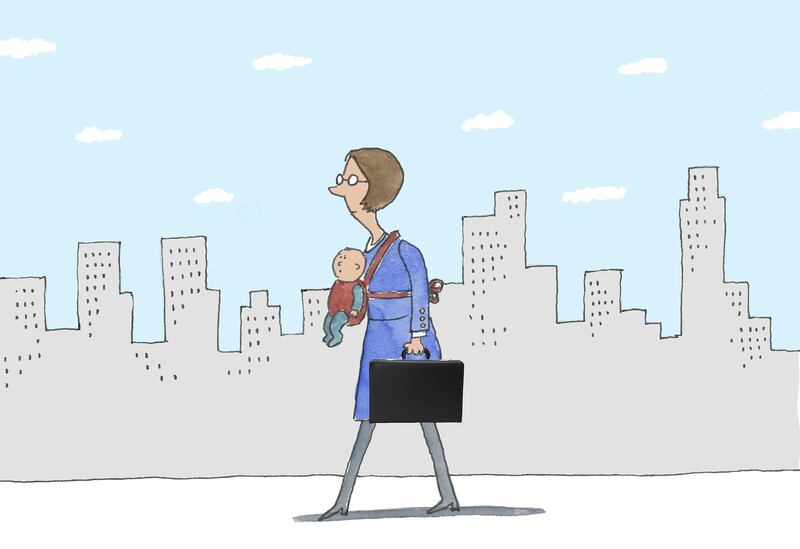Here is my sincere message to you ahead of International Women’s Day on March 8: lean in to earning, even if it’s a seemingly worthless amount - especially if you’re a woman.
This is important because you are important. It’s not so much what you earn, as what you lose if you don’t, unless you already have a trust fund.
It pains me to say this because I advocate a life of selective working, depending on what phase you’re in. In a way, we’re living our lives the wrong way around. I’d much rather have had time with my child in his formative years, than leaning in to work. Perhaps you feel the same, or have this as a future aspiration.
Taking time off to care for family is the number one reason women, on average, ended up earning 49 per cent of men’s wages over a 15-year period. The figures were collated from 2001 all the way up to 2015; these are real lives, real people and real wages. The Panel Study of Income Dynamics by the US’s University of Michigan is the world’s longest running household panel survey.
It began with 18,000 individuals, from 5,000 families in 1968. Information about these people and their descendants has been collected continuously for the past 50 years. The findings have been segmented into three year groups – with the latest running from 2001 until 2015.
I want us to focus on the last grouping of data – the 15 years to 2015 – because it indicates what the current earnings reality is.
The reason the women earned so little: they took time off. Why? For family reasons.
Had these women stayed working full time, we’re told they would have earned 80 cents to each dollar earned by a man. This has come to be known as the gender pay gap, and is cited as a ‘fact’.
The system is flawed. It only takes into account women at work, women who are earning. This means women who have stepped out of work – who are carers to children or elderly parents, for example – are not included.
Forty-nine cents to the dollar appears to be the real amount women earn over a decade and a half – on average.
But, I believe this too is unrealistically optimistic.
You see, it only tackles missed pay-cheques. It does not add up the incremental, life-long losses of stepping out of work – like salary increases along the way, and much, much more. It’s money that can never be recovered.
Sometimes women lean out with the conviction that they will go back to earning once their carer-time is done. The reality is harsh: 65 per cent of women returning to work (and lucky enough to get a job, not everyone is) are employed below their skill set – which means they are earning below their ability level, according to PwC.
Instead of leaning out, consider what earning even a seemingly ‘worthless’ amount does. This is a typical scenario: your partner earns more, and you have jointly decided that it’s not financially worth you working and having to pay for childcare or nursery while your child/ children are very young. Plus, emotional stability is priceless.
Imagine, if only you cleared $500 dollars a month after childcare expenses. You would kill yourself to do this – going to work and being pulled in two different directions. So the (reasonable) thinking is, it’s not worth the hassle and that you would be so much more present in your child’s life if you stop and you, as a family, take the $500 dollars hit each month. That way you gain as a stay at home parent and partner and continue this until the child is 5.
My assumption is that your family does not need the $500 dollars to live on. But, let’s go over the number-soup. If you start with zero in the bank, and put $500 (of whatever currency) into an account every month, an account you do not touch, and that compounds annually at an assumed 5 per cent, then at the end of five years you’ll have $34,045.01 in the bank.
If you were to leave it alone for the next 20, that becomes $90,331.55. If you continue to add $500 to it each month beyond the five-year period, for 20 years, it becomes $294,060.44.
So the question is: do you need that future money in your life? And if so, how can you make the monthly payments happen?
Perhaps you negotiate flexi-work for five years, perhaps you invent a side-job – the term mumpreneur exists for a reason - or your partner provides the $500 each month. This has nothing to do with trust, and everything to do with future dignity.
The odds are stacked against you. You are more likely to be living out your last years – if not decades – alone and in need of medical care, or everyday assistance of some sort, than the man in your life.
So, lean in to earning - in some way - until you are financially independent.
Nima Abu Wardeh is a broadcast journalist, columnist and blogger. Share her journey on finding-nima.com







